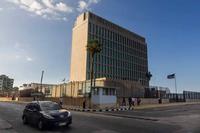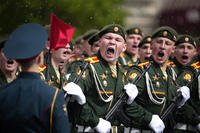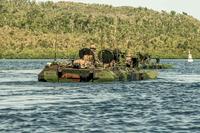Joint Strike Fighter engineers will have to make adjustments to the weapons bay of the Marine Corps variant of the F-35 so the aircraft can carry a pin point glide bomb by 2022, JSF program officials said.
The Small Diameter Bomb II, or SDB II, can acquire and track moving targets from distances up to 40 miles and is slated to enter service by 2017. However, while the weapon can be integrated into the Air Force's F-35A variant, the new weapon cannot fit into the current configuration of the Corps' F-35B short-take-off-and-landing variant of the JSF, F-35 program officials acknowledged.
JSF officials said the SDB II was not intended to integrate onto the Marine Corps variant before 2022 and therefore "not an issue or problem." However, the changes will require modifications to the internal weapons bay before it can be integrated.
The JSF program says the program is waiting to make these modifications because the SDB II is a developmental weapon and there may be other adjustments needed to the internal weapons bay to accommodate other future weapons, JSF officials explained.
The SDB II is not intended to deploy on the F-35B when it reaches operational status later this year. The software configuration onboard the F-35B will not be able to fire the SDB II until 2022, JSF officials said.
JSF officials could not say how much the modifications to the internal weapons bay of the F-35B will cost because they are still being determined and not slated to begin for several years.
The Small Diameter Bomb II represents a technological departure from other precision-guided air-dropped weapons because of its ability to track and hit moving targets from long distances.
A key part of the SDB II is a technology called a "tri-mode" seeker - a guidance system which can direct the weapon using millimeter wave radar, uncooled imaging infrared guidance and semi-active laser technology.
Meanwhile, the Air Force's F-35A Joint Strike Fighter variant is making progress with its weapons separations testing, Air Force officials said.
"We've had a busy year in terms of looking at doing testing for weapons separation," Lt. Gen. Ellen Pawlikowski, military deputy for Air Force acquisition, said.
Since last year the Air Force has had four different AIM-120 tests as well as a few Small Diameter Bomb separation tests and some JDAM tests, she added.
Pawlikowski said weapons preparation is on track for the Marine Corps short-take-off-and-Landing F-35B variant as well, adding that it is slated to reach operational status, called initial operating capability or IOC, by this summer.
"The weapons preparation is on track to support the Marine Corps and Air Force IOCs," she added.
Meanwhile, in November of last year, the Joint Strike Fighter completed three live-fire weapons delivery accuracy tests involving two AIM-120 Advanced Medium Range Air-to-Air Missile, or AMRAAMs and one Joint Direct Attack Munition, or JDAM.
"These events included the first supersonic-guided missile launch and the first JDAM release on target coordinates generated from the Electro-Optical Targeting System," a JSF program office statement said.
The F-35 can carry more than 35-hundred pounds of ordinance in low observable or stealth mode and over 18-thousand pounds uncontested.
There are 11 weapons stations built onto the F-35 airframe; four of them, weapons stations four, five, seven and eight are internal weapons stationed engineered to allow the aircraft fly and drop weapons while in stealth mode, JSF officials said.
However, there is an exhaustive separation process and extensive evaluations involving testing weapons "drops" before weapons are live-fire tested against targets, Pentagon JSF officials said.
"We take a crawl, walk, run approach to weapons testing where we will begin by putting a weapon in a weapons bay and dropping it on land onto some padding. Then, they will test the weapon flying to see if it releases and drops safely. Then you connect to the last stage and test whether the weapon can find the target," said Joe DellaVedova, JSF spokesman.
F-35 weapons separation testing has also involved the GBU-39 Small Diameter Bomb, Paveway IV missiles and external "flutter tests" with the AIM-132 Advanced Short Range Air-to-Air Missile.
Overall, the Air Force plans to buy 1,763 JSF F-35A multi-role fighters.
In January of this year, the Air Force stood up a special F-35 integration office to ensure that all aspects of the platform are properly developed, Pawlikowski added.
She added that some of the technologies, such as intelligence, reconnaissance and surveillance ability, or ISR, and increased sensing capacity on the F-35 might lead the Air Force to develop new concepts of operation, tactics and procedures for the platform.
"I don't know that we have a full appreciation of everything we are going to be able to do with the F-35 until we start to actually use it," Pawlikowski said.
-- Kris Osborn can be reached at Kris.Osborn@military.com

























